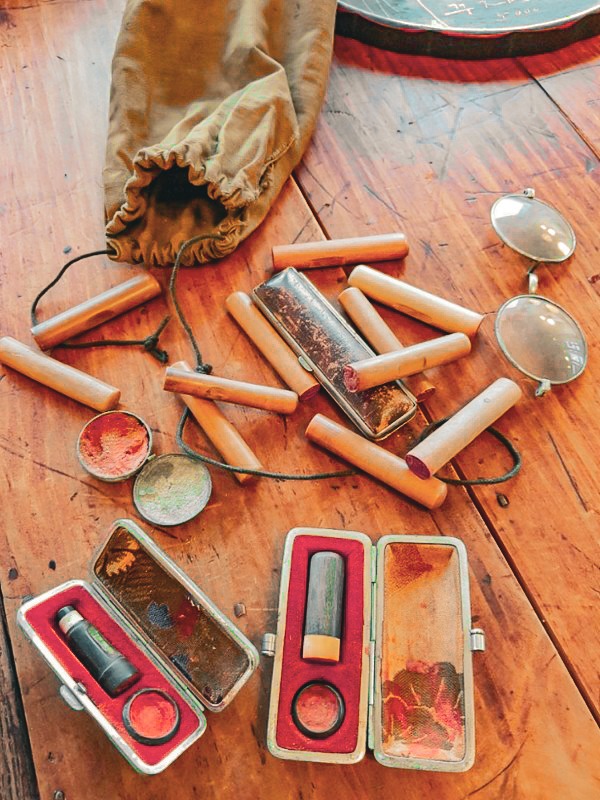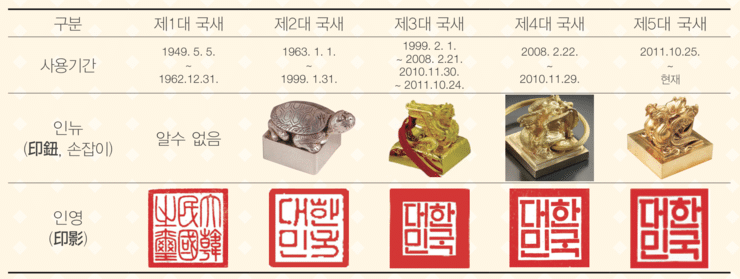The Korean Dojang: How To Get A Korean Name Stamp
Last Updated on March 19, 2024
If you’re living in Korea and you’ve ever wondered why the area to put your signatures on forms is so small, the answer is the dojang. I’m sure I’m not the only one that went from a full name signature to just using my initials when signing everything from bank books to contracts after moving to Korea. Wondering what that name stamp is every Korean person seems to have when they go to sign a contract? Let me fill you in.
In Korea, a dojang (도장) is a seal or stamp with one’s name or signature. Whether you want one for legal purposes in Korea or if you are just looking for a unique souvenir from Korea, definitely look in to the dojang.

From the history of the Korean seal to where you can get your own name stamp and how to use it, let’s dig in.
- What is a dojang?
- The History of the Korean Seal
- Why do Koreans use a name stamp instead of a signature?
- What documents can I use a dojang on?
- Where to make a dojang in Korea
- Where to buy a dojang online
- What materials are used to make a dojang?
- How much does a Korean name seal cost?
- Can foreigners use a dojang in Korea?
- How to use a dojang
(This post contains affiliate links, which means I receive a certain percentage of a sale if you purchase after clicking at no cost to you. Thank you for your support.)
What is a dojang?
A dojang is a traditional Korean seal or stamp used to signify one’s personal name or signature. These stamps have been an integral part of Korean culture since ancient times. The word “dojang” itself has a deep historical significance, as it dates back to the Three Kingdoms period (57 BC – 668 AD). During this era, dojangs were primarily used to authenticate documents and other important items. However, their usage evolved over time, becoming emblematic of personal identity and authority. During the Joseon Dynasty (1392 – 1910), the dojang went from largely only for official agencies and trickled down to individuals. (This is kind of like how metal chopsticks really got their start in Korea.)


Today, if you’re ever with a Korean person when it’s time to sign a housing contract, create a bank account, or other important thing, you’ll notice instead of signing with a pen, they reach for a stamp and ink; this is a dojang, well actually an ingam. Legal dojangs are called ingam (인감) , with the only difference being that one is registered with the government and one is not.
The History of the Korean Seal
The history of dojangs in Korea is closely intertwined with the nation’s founding mythology. There’s a story about the foundation of Korea that’s important to know to understand the history of the dojang.


According to legend, Hwanung, one of the King of Heaven’s younger sons, descended to Earth to live among the valleys and mountains of the Korean peninsula. He carried with him three heavenly dojangs, and upon seeing these seals, the people accepted him as their leader. Hwanung later named his son, Dangun, as the King of Gojoseon in 2333 BC, marking the foundation of the first Korean kingdom. This momentous event is celebrated annually on October 3rd as Gaecheonjeol (개천절), a national holiday in Korea. All of this to say that Korea’s foundation is all thanks to a dojang sent from heaven.

Throughout Korea’s dynastic history, including the Joseon Dynasty (1392-1910), official dojangs called ingam (인감) were registered with the government and used for signing official documents. In 1945, when the Republic of Korea was officially established, a new type of state seal called the guksae (국새) was introduced for diplomatic use.
Families also adopted their personalized dojangs, which featured their names in Hangul (Korean script) or Hanja (Chinese characters). These were used for various purposes from the official to the unnofficial, including signing personal correspondence, artwork, and crafts. If you have any traditional Korean souvenirs like a najeonchilgi box, look closely at the bottom and you’ll likely find a stamp as craftsmen and artisans still use them today.

Why do Koreans use a name stamp instead of a signature?
While signatures are the prevalent method of authentication in many parts of the world, Koreans have a deep-rooted preference for using dojangs. They also consider a stamp to be more secure than a signature as it’s more difficult to forge. The unique designs of each stamp make them almost impossible to duplicate.
Even today, dojangs are regarded as symbols of personal identity and authority. Official government offices and modern-day officials in Korea continue to use dojangs to seal formal transactions. The practice of using a dojang imparts a sense of authenticity and formality to documents.
Stamping a document is very similar to, if not exactly the same as, the seals of authenticity we need to get on all of our foreign documents when we bring them to Korea to authenticate them. Koreans have just chosen to use seals on a more personal level than a lot of other countries.
What documents can I use a dojang on?
In Korea, dojangs can be used on a variety of documents, both official and personal. Official documents often require the use of a legal dojang which is registered with the government. When a dojang is registered with the government, it becomes an ingam. Personal dojangs are used for signing artwork, letters, and other personal items.
While registered dojangs, or ingam, can be used on everything including:
- Contracts including rental agreements, employment contracts, sales contracts, business leases, consulting agreements, partnership agreements, etc.
- Bank documents
- Legal documents like a power of attorney, certificate of inheritance, or court document.
- Tax-related documents
- Government applications like a passport, driver’s license, or any other type of government-issued identification.
- Business-related documents like a business proposal, invoice, or any other type of business document.

Where to make a dojang in Korea
If you find yourself in Korea and wish to create your own dojang, you’re in luck. The Insadong area in Seoul is a hub for dojang shops. While these storefronts may appear small and unassuming, they house a world of craftsmanship and tradition inside. Some shops will do everything for you, while some make a whole experience out of it and you can learn how to make your own.
Create your own Korean name stamp in Insadong
- Handmade Stamp Engraving on Klook: Work with traditional tools to carve your own dojang in Insadong.
- Yhlayuen Jeongak Academy on kkday: Another great place to learn how to carve your own name stamp in Insadong.
Before you visit, make sure you decide what name you want on the stamp. Will it be in Hangul, English, or Hanja? If you choose Hangul or Hanja, make sure you ask someone who is a native speaker to check to ensure it’s correct.
Where to buy a dojang online
For those who are not in Korea but still wish to own a dojang, the internet offers a convenient solution. Online marketplaces like Etsy and Amazon feature various dojang options. You can customize your dojang, choosing between Korean or Chinese characters, or even English. Be sure to message the seller to ensure you receive the exact dojang you desire.
What materials are used to make a dojang?
One fascinating aspect of dojangs is the wide variety of materials from which they can be crafted. These materials include colorful plastics, animal bones, ivory, wood, stone, gems, and even emperor’s jade. Mine is wood and my husband’s is a stone.
Korean people have a particular affinity for jujube wood struck by lightning, as it is believed to protect against bad luck and bring blessings. This unique wood, which sinks like a stone in water and often bears the scar of a lightning strike, is sometimes fashioned into jewelry.


Dojangs come in various shapes, including round, oval, square, or rectangular, and can be sculpted into unique forms. The engraving on the dojang’s face can feature Korean or Chinese characters, English, art, symbols, or even a person’s face.
Just an aside, I’ve always found it interesting that while you should never write a person’s name with red ink in Korea, all of the stamp ink for dojangs is a very blood red.
How much does a Korean name seal cost?
The cost of a Korean dojang can vary widely depending on the complexity of the engraving on the exterior as well as the complexity of the engraving of the stamp itself and the materials used. They can range in price from W30,000 to hundreds.
Can foreigners use a dojang in Korea?
If you think you’re relegated to foreigner trying to fit your signature into those tiny boxes on documents, you might be happy to know that foreigners can also use dojangs in Korea, both officially and unofficially.
While the legal head of every household maintains a dojang to register as a citizen with the local governing office, foreigners can also personalize their own dojangs for various purposes. Whether it’s signing artwork, letters, or other personal items, a dojang can be a unique and meaningful addition to a foreign resident’s life in Korea.


How to make a dojang legal in Korea so you can use it
To make a seal legal, the owner of the name stamp must go in person and present their Korean ID card, or someone with a power of attorney can go.
- Go to your local district office, or dongsamuso (동사무소).
- Fill out the application and they will issue a so-called “seal certificate” on request, which contains your personal data such as name, address and ID number as well as a picture of the registered seal imprint.
Once you have a dojang, especially if you’re registered it and it is now your legal signature in Korea, make sure you protect it and keep it in a secure location.
Important note: Keep in mind that up-to-date seal certificates need to be obtained from the district authority regularly, because of the limited validity of three months from date of issuance that official documents in Korea have in common. When using valid seal certificates, no other notarizations are required, at least not for Korean documents sealed for legal transactions in Korea.
How to use a dojang
When you’re signing a contract in Korea, you might notice that there are some different ways that the paperwork is signed. Koreans don’t only sign the last page of contracts. If the document is multiple pages, to seal them, you need to do what is referred to as ganin (간인). This means that the document is not only sealed on the last page where the signature fields are, but on every single page.
When doing ganin, the first page of the document is folded so that its backside is visible. The seal is then stamped on the fold, so that half of the imprint is on the backside of the first page and the other half is on the front of the second page. This method is repeated throughout the whole document for every page. It is therefore easy to prove of which pages a document consists of.
With a history dating back to ancient times, these seals have retained their significance in a modern world that often favors digital signatures. The rich variety of materials, shapes, and engravings available for dojangs allow you to express your unique style and preferences. Whether you get one for legal purposes or just for a fun souvenir from Korea, the Korean name stamp is a beautiful example of Korean culture and tradition.
Did you like this post? Pin iT!



